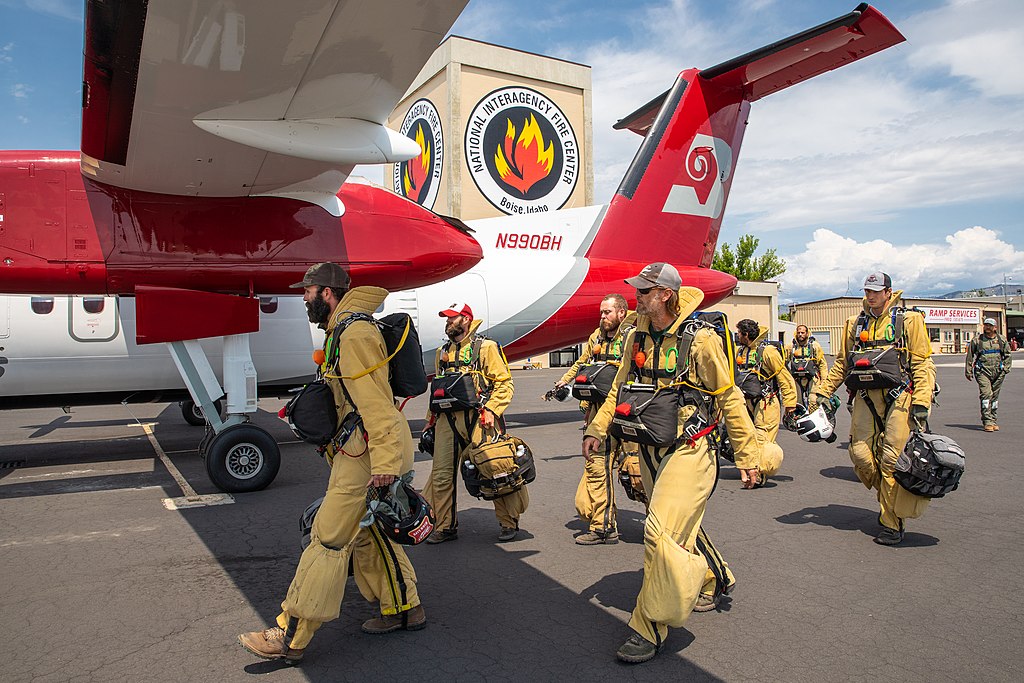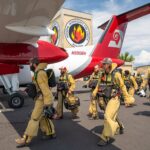
Bureau of Land Mangement smokejumpers prepare for a training jump in Boise, Idaho. (DOI/Neal Herbert)
BY: ALFORD STONE
Smokejumping, an elite and adrenaline-fueled profession within the realm of wildland firefighting, epitomizes courage, skill, and unwavering commitment. As we delve into the captivating world of smokejumping, we unravel the stories of these airborne firefighters who brave the untamed wilderness to combat blazes in some of the most remote and challenging terrains on the planet.
The Pioneering Spirit of Smokejumping
Originating in the 1930s, smokejumping emerged as a response to the increasing difficulty of accessing and combating wildfires in rugged and isolated landscapes. The United States Forest Service (USFS) spearheaded this innovative firefighting strategy, forever changing the landscape of wildland fire management.
The first experimental jump took place in 1939 in Winthrop, Washington, as fearless firefighters leaped from an aircraft to extinguish a small blaze. This daring endeavor marked the birth of a specialized firefighting force that would evolve into the modern-day smokejumping community.
Training for the Skies
To become a smokejumper, individuals undergo rigorous training that separates the ordinary from the extraordinary. Training programs, often based in specialized centers such as the McCall Smokejumper Base in Idaho, emphasize physical fitness, mental resilience, and comprehensive firefighting skills.
Trainees endure intensive physical conditioning to prepare for the demands of parachute jumps and the challenging conditions they may encounter in the field. The mental fortitude required for smokejumping is equally crucial, as smokejumpers often find themselves facing unpredictable weather, rugged terrain, and the isolation of the wilderness.

Parachute Proficiency
Central to the smokejumper’s skill set is expertise in parachute operations. Smokejumpers must master the art of precision parachuting to ensure safe landings in areas where conventional firefighting crews struggle to reach. The parachutes themselves are specially designed for smokejumping, offering a balance between control and maneuverability.
Precision landing is critical, as smokejumpers need to position themselves strategically close to the fire to minimize response time. The ability to navigate challenging landscapes while suspended beneath a parachute sets smokejumpers apart as a unique and indispensable firefighting force.
The Aircraft: A Portal to the Frontlines
Smokejumpers rely on purpose-built aircraft to transport them swiftly and efficiently to the heart of wildfires. Typically, these aircraft are outfitted with modifications to accommodate the specialized needs of smokejumping missions. The aircraft serve as a lifeline for smokejumpers, providing them with the means to reach remote locations that would otherwise be inaccessible.
The Jump: Into the Inferno
A smokejumper’s mission begins the moment they exit the aircraft and descend into the unknown. The jump itself is a meticulously orchestrated dance with gravity, wind, and terrain. Once on the ground, smokejumpers must quickly regroup, assess the situation, and formulate a strategy to contain and suppress the fire.
Facing the Elements
Smokejumpers often find themselves battling more than just flames. The unforgiving elements of nature, from blistering heat to bone-chilling cold, add an extra layer of complexity to their missions. In the rugged wilderness, where firefighting resources are scarce, smokejumpers become the first line of defense against nature’s fury.
Remote Fire Suppression
One of the defining features of smokejumping is the capacity to access and tackle fires in remote and otherwise unreachable locations. These may include mountainous terrains, dense forests, or even uninhabited wilderness areas. The ability to respond swiftly to emerging threats in these environments is a testament to the value of smokejumpers in the broader firefighting ecosystem.
Team Dynamics
Smokejumping is inherently a team effort, requiring seamless collaboration and trust among team members. The close-knit nature of smokejumper crews fosters a unique camaraderie, as individuals rely on each other in the face of adversity. The success of a smokejumping mission hinges on the collective skills, communication, and synergy of the team.
The Toll on the Body and Mind
The challenges of smokejumping extend beyond the physical realm, taking a toll on the mental well-being of these brave firefighters. The high-stakes nature of their missions, coupled with the inherent risks of parachuting into volatile fire environments, demands a level of mental resilience that few professions require.
Celebrating the Heroes
Smokejumpers often operate behind the scenes, their efforts hidden within the vast expanses of wilderness. Yet, their contributions are immeasurable, as they safeguard communities, protect ecosystems, and preserve the delicate balance of our natural landscapes.
Smokejumping stands as a testament to the human spirit’s ability to confront and conquer the most formidable challenges nature presents. As these airborne firefighters leap into the unknown, they embody courage, skill, and a profound dedication to preserving the beauty of our planet. In the annals of firefighting history, smokejumpers etch a remarkable chapter, soaring into the skies and confronting the infernos that threaten our world.






